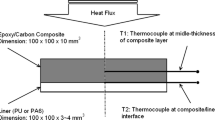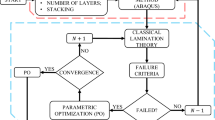Abstract
We must improve our understanding of the thermal behaviour of composite gas storage in the event of fire in order to reduce the risk of bursting. In this research, results of pool fire tests were used to improve understanding of the failure mechanisms of epoxy carbon fibre composite pressure vessels with a polymeric liner (type IV vessel) designed for a working pressure of 70 MPa. The failure mode in a pool fire test depends on the storage design and on the initial pressure of the storage. For instance, for a 100 L type IV storage without any safety system, initial pressures of 70 MPa down to 52.5 MPa result in pressure vessels bursting, and initial pressures of 35 MPa down to 17.5 MPa lead pressure vessels to loss of liner tightness. The occurrence of one mechanism or the other is due to the predominance of either heat transfer through the wall, leading to a loss of tightness; or of the degradation of the materials, leading to bursting. Thermogravimetric analyses were carried out on the pressure vessel materials to determine the onset of degradation take during pool fire tests. The temperature measurements allowed for proper characterisation of the conditions leading to the loss of liner tightness. Temperature profiles were used to link the position of the composite degradation front to the loss of tensile strength leading to bursting.














Similar content being viewed by others
Notes
The cylinders are grouped by type: I for traditional metallic cylinders, II for cylinders reinforced in the cylinder part, III for fully-wrapped vessels with metallic liner, IV for fully-wrapped vessels with polymeric liner and V for fully-wrapped vessels without liner.
In this article, we summarize all the parameters listed in the standard NF EN 12245 relevant to our tests. It is highlighted that the description of the bonfire test setup in the standard is not very precise.
References
World Intellectual Property Organization (2009) Patent-based technology analysis report—Alternative Energy Technology. http://www.wipo.int/. Accessed 12 December 2013.
Barthélémy H (2012) Hydrogen storage—industrial prospective. Int J Hydrogen Energy 37:17364–17372.
Bunsell AR, Renard J (2005) Fundamentals of fibre reinforced composite materials. Institute of Physics Publishing, Bristol.
US Department of Transportation (2010) Localized fire protection assessment for vehicle compressed hydrogen containers. DOT HS 811 303.
Zheng J, Ou K, Bie H, Xu P, Zhao Y, Liu X, He Y (2012) Heat transfer analysis of high-pressure hydrogen storage tanks subjected to localized fire. Int J Hydrogen Energy 37:13125–13131.
Zheng J, Ou K, Hua Z, Zhao Y, Xu P, Hu J, Han B (2013) Experimental and numerical investigation of localized fire test for high-pressure hydrogen storage tanks. Int J Hydrogen Energy 38:10963–10970.
Mouritz AP, Feih S, Kandare E, Gibson AG (2013) Thermal–mechanical modelling of laminates with fire protection coating. Compos B 48:68–78.
Feih S, Mathys Z, Gibson AG, Mouritz AP (2007) Modelling the tension and compression strengths of polymer laminates in fire. Compos Sci Technol 67:551–564.
Mouritz AP, Feih S, Kandare E, Mathys Z, Gibson AG, Des Jardin PE, Case SW, Lattimer BY (2009) Review of fire structural modelling of polymer composites. Compos A 40:1800–1814.
Feih S, Mouritz AP (2012) Tensile properties of carbon fibres and carbon fibre–polymer composites in fire. Compos A 43:765–772.
Bai Y, Keller T, Vallée T (2007) Modelling of thermo physical properties and thermal responses for FRP composites in fire. In Asia-Pacific conference on FRP in structures (APFIS 2007).
Quang Dao D, Luche J, Richard F, Rogaume T, Bourhy-Weber C, Ruban S (2013) Determination of characteristic parameters for the thermal decomposition of epoxy resin/carbon fibre composites in cone calorimeter. Int J Hydrogen Energy 38(19):8167–8178.
Zalosh R (2008) CNG and hydrogen vehicle fuel tank failure incidents, testing, and preventive measures. In Spring Meeting & 4th Global Congress on Process Safety.
US Department of Transportation (2010) Analysis of published hydrogen vehicle safety research. DOT HS 811 267.
Ruban S, Heudier L, Jamois D, Proust C, Bustamante-Valencia L, Jallais S, Kremer-Knobloch K, Maugy C, Villalonga S (2012) Fire risk on high-pressure full composite cylinders for automotive applications. Int J Hydrogen Energy. doi:10.1016/j.ijhydene.2012.05.140.
Tamura Y, Takabayashi M, Takeuchi M (2014) The spread of fire from adjoining vehicles to a hydrogen fuel cell vehicle. Int J Hydrogen Energy 39:6169–6175.
Zalosh R, Weyandt N (2005) Hydrogen fuel tank fire exposure burst test. SAE Paper Number 2005-01-1886.
Zalosh R (2007) Blast waves and fireballs generated by hydrogen fuel tank rupture during fire exposure. In Proceedings of the 5th international seminar on fire and explosion hazards, Edinburgh, April 2007, pp 23–27.
Polanský R, Mentlík V, Prosr P, Sušír J (2009) Influence of thermal treatment on the glass transition temperature of thermosetting epoxy laminate. Polym Testing 28:428–436.
Fateh T (2011) Etude expérimentale et numérique de la cinétique de décomposition thermique de contreplaqués en bois. PhD Thesis.
Bustamante-Valencia L (2009) Experimental and numerical investigation of the thermal decomposition of materials at three scales: application to polyether polyurethane foam used in upholstered furniture. PhD Thesis.
Afnor (2009) NF EN 12245: 2009—Transportable gas pressure vessels—Fully wrapped composite cylinders. ISSN 0335-3931.
Drysdale D (2011) An introduction to fire dynamics. Wiley, Chichester.
Bradley I, Phylaktou HN, Andrews GE (2013) The development of a pool fire test procedure for LPG vessels using propane gas burners. In: Proceedings of the seventh international seminar on fire & explosion hazards (ISFEH7), pp 210–219.
Yang Z, McElrath K, Bahr J, D’Souza NA (2012) Effect of matrix glass transition on reinforcement efficiency of epoxy-matrix composites with single walled carbon nanotubes, multi-walled carbon nanotubes, carbon nanofibers and graphite. Compos B 43:2079–2086.
Villalonga S, Thomas C, Nony F, Thiebaud F, Geli M, Lucas A, Kremer-Knobloch K, Maugy C (2011) Application of full thermoplastic composite for type IV 70 MPa high pressure vessels. In Proceedings of the 18th international conference on composite materials.
Hu J, Chen J, Sundararaman S, Chandrashekhara K, Chernicoff W (2008) Analysis of composite hydrogen storage cylinders subjected to localized flame impingements. Int J Hydrogen Energy 33:2738–2746.
Acknowledgments
The authors would like to acknowledge OSEO H2E pour their financial support for this research work and Thomas Rogaume for fruitful discussions.
Author information
Authors and Affiliations
Corresponding author
Rights and permissions
About this article
Cite this article
Bustamante Valencia, L., Blanc-Vannet, P., Domergue, D. et al. Thermal History Resulting in the Failure of Lightweight Fully-Wrapped Composite Pressure Vessel for Hydrogen in a Fire Experimental Facility. Fire Technol 52, 421–442 (2016). https://doi.org/10.1007/s10694-015-0513-y
Received:
Accepted:
Published:
Issue Date:
DOI: https://doi.org/10.1007/s10694-015-0513-y




